Mussolini's arrival in Ukrainian Uman
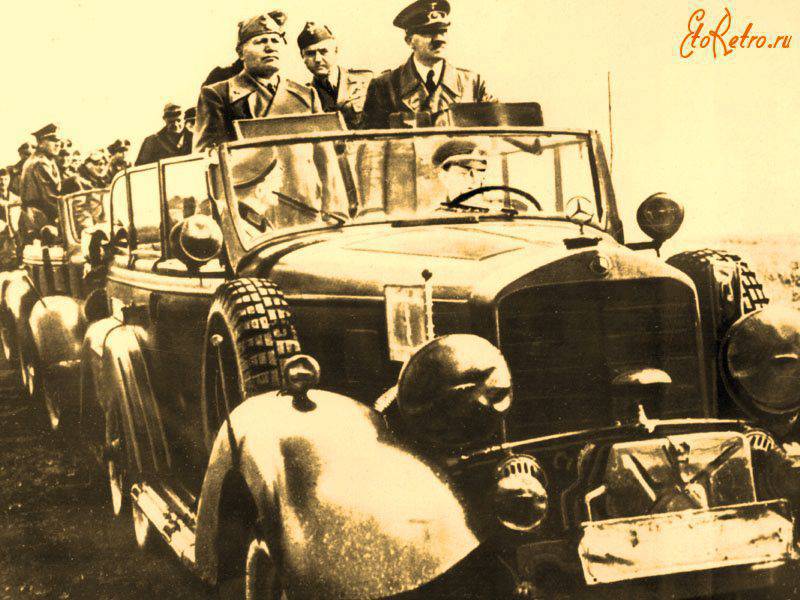
The Central Archive of the Ministry of Defense of the Russian Federation has a unique photo. It depicted Hitler and Mussolini, which in principle is not surprising. Unusual in it is a place where two fascist leaders were photographed. And they were shot in Uman 28 August 1941 of the year. What brought the Fuhrer and the Duce in August 1941 to the district center of Cherkasy region?
As early as July 1941, hostilities on the entire Soviet-German front did not develop at all as Hitler’s strategists had suggested. The offensive of the Nazi troops met with ever more fierce resistance. Our troops more and more often forced the enemy to go on the defensive.
The unforeseen course of the hostilities forced Hitler and the higher German leadership to make serious adjustments to the originally approved plans and calculations. After taking possession of Smolensk, during which the Red Army was able to inflict heavy damage on the enemy, the situation in the Moscow sector changed. The increased resistance of the Soviet troops put the Hitlerite command before a dilemma: to attack Moscow or deploy a significant part of the troops from Moscow to the south and achieve decisive success in the area of Kiev.
It must be said that Hitler was increasingly attracted by the idea of a quick seizure of the Donbass, the Caucasus, and the rich agricultural plots of Soviet Ukraine. On July 23, 1941, Keitel ordered Brauchitsch to direct the efforts of two tank groups to capture the industrial region of Kharkov, and then advance through the Don to the Caucasus. At the same time, it was proposed to send the main forces primarily to capture Ukraine, Crimea, as well as central regions to the Don. Hitler hoped that by the beginning of the autumn thaw, German mobile units would be able to reach the Volga and enter the Caucasus.
Thus, despite the fact that the fascist blitzkrieg failed in terms of tasks and objectives, Hitler still hoped to end the campaign “before the autumn leaf fall”. However, to solve this problem, replenishment was needed. Moloch war demanded all new victims. It was Italy’s turn to make a contribution to the Fuehrer’s adventurous “campaign to the East.”
Initially, Hitler did not plan to involve Italy in the war against the USSR, since he did not consider her a strong enough ally and did not intend to share the fruits of his victory, which he intended to win before winter. But the stubborn resistance exerted by the Wehrmacht by Soviet troops already in the first month of the war showed Hitler that it was unwise to refuse to use military aid from Italy. Moreover, Mussolini was eager to participate in the colonial robbery on the territory of Russia. “Will the Italian troops be late for Russia?” The duce asked the German military attache frankly in the summer of 1941.
Finally, the Duce received a long-awaited letter from Hitler. At the beginning of the message, the Führer shared his first impressions of the development of hostilities in the East. Hitler did not hide the fact that the resistance of the Soviet troops was stronger than he could have imagined. “Russian soldiers are fighting fanatically,” the Führer noted and complained that the presence of 54-ton tanks in the Red Army was a complete surprise to the German General Staff. “I truly accept your generous offer to send an expeditionary corps and fighter units to the eastern theater of operations,” further wrote Hitler Mussolini. At the end of his letter, the Führer made a duke an offer to meet on the Russian front, which very much flattered the latter's pride.
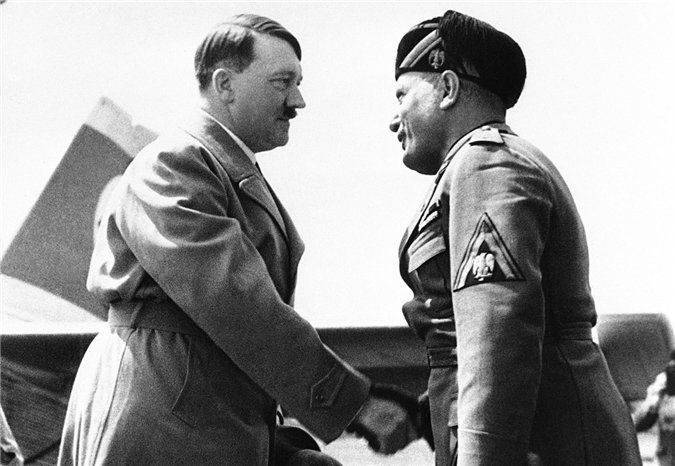
The Italian General Staff did everything possible to prepare the expeditionary corps well for dispatch to the Eastern Front. Mussolini himself kept a close eye on the preparations. In his head, plans were already ripe to increase Italy’s contribution to the struggle against the USSR and to bring the number of troops sent to the eastern front to one army. During the 5 performance on July 1941, before the Council of Ministers, the Italian dictator shared his thoughts that after the German victory over the Soviet Union, the disparity between the German and Italian contributions to the axis may be too great. This, he said, was guided by the sending of Italian forces to the Eastern Front.
However, Mussolini was cunning. He was simply afraid to be late to divide the skins of an unkilled bear and therefore sought to secure the promise of favorable economic compensation for participating in the campaign. Formally, this promise was received. In a letter from 20 in July, Hitler wrote that the vast Russian lands and resources "would ensure such economic conditions that, even if the war continues, will give the rest of Europe everything they need."
The Chief of the General Staff, U. Cavaliero, was also not against raising the level of the Italian military industry at the expense of future seizures; however, with experience in working with the German military and political leadership, he was quite skeptical. He believed that it was not worth to rely on Soviet resources, since the main part of the military production will go to the Germans.
However, 10 July 1941, the expeditionary corps consisting of two Italian mechanized divisions "Pasubio" and "Torino", as well as the infantry division "Celera", which was named after Prince Amedeo of the Duke of Aosta, moved to the east. 226 railway trains carried thousands of Italians across European territory. When they were sent, according to the usual rule of the Italians, many speeches were made. General Messe, who led the expeditionary corps, called on his soldiers to fight for Ukraine more boldly - the future winners' breadbasket. In Italy these days there was clear weather, and it seemed to everyone that the sun would accompany the Italian army throughout the campaign. Nobody doubted that everything would be over by the beginning of winter, and the gallant warriors would return home with military awards and rich trophies.
However, the troubles began immediately, even before the expeditionary force left the borders of Italy. The rolling stock, which was urgently assembled throughout the country, was not properly prepared for such a long journey. On the Brenner mountain pass, one of the echelons exploded in half, and 17 soldiers from the Pasubio division were out of action. So the case suffered the first losses in its homeland. In 27 days, the Italians arrived in Ukraine.
Hitler ordered under any circumstances not to allow the presence of Italians in the coastal areas of the Black Sea and categorically not to allow them to the Crimea, which according to the plans of the Fuhrer was to become the region of undivided domination of the German Reich. Therefore, the command of the 11 Army, whose composition was to include the Italian Expeditionary Force, was sent a secret order to use the Italian units exclusively on the left flank, the most distant from the Black Sea.
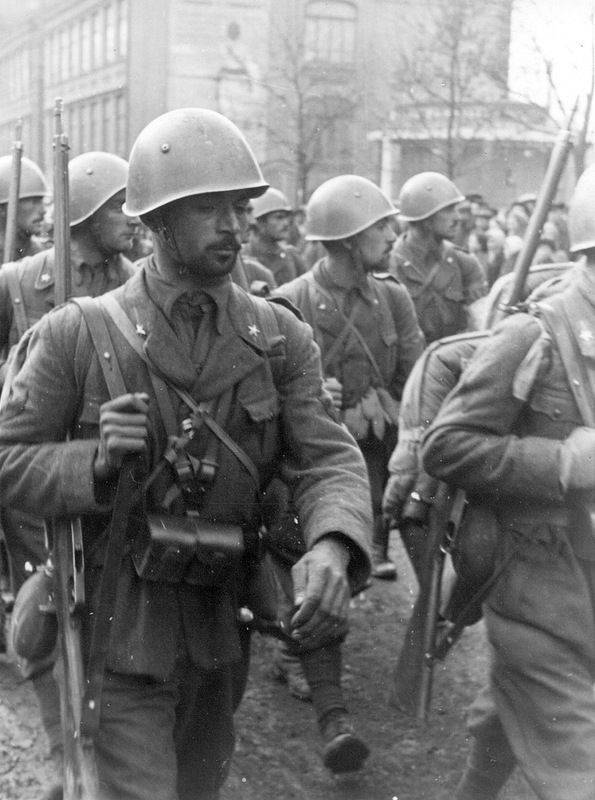
Meanwhile, the situation for the Soviet troops of the South-West direction at the beginning of August 1941 was extremely unfavorable. August 1 Day was a turning point for the 6 and 12 of the Soviet armies. By morning, these armies were completely surrounded in the Uman area. The ammunition ran out, the fuel was running out. Attempts to break through the ring were unsuccessful. 7 August resistance of the Soviet troops was broken. According to German data, the 103 of thousands of our soldiers and officers were captured near Uman. The troops of the Southern Front lost two armies. Hitler assessed the encirclement of the Soviet armies near Uman as the achievement of Army Group South by his first strategic goal.
During the visit of the Fuhrer 4 in August 1941 of the year to the Army Group Center (Borisov), the main issue was again discussed - the definition of strategic goals and the use of forces in the second stage of operations. 6 August Hitler arrived in Berdichev, where at that time the headquarters of Army Group South was located. The discussion of the plan of further actions was continued again. According to the recording made by Halder, the question was again raised about the importance of seizing Moscow. Hitler again explicitly rejected these proposals. He again insisted on his own words: “First you need to seize Leningrad ... Then you should occupy the eastern part of Ukraine ... And after that start the offensive in order to capture Moscow”.
Then Rundstedt reported on the success of the operations that were at that time carried out by Army Group South. The Fuhrer approved his report. He was especially pleased to hear about the rapid advance of the Kleist tank group against the city of Krivoy Rog, since, in Hitler's opinion, in this area there were extremely rich deposits of iron ore and a large metallurgical base. At the end of the meeting, an award was given to the knights' cross of Antonescu.
Fulfilling the order of Hitler, the German command launched an offensive in the directions of Starodub, Gomel, Konotop, Chernigov. Considering the created threat to the right wing and the backs of the Southwestern Front, the 19 August Headquarters ordered the armies of the Southwestern Front to withdraw beyond the Dnieper and organize defense on its eastern bank. On the west bank of the river, only Kiev was ordered to be held.
Somewhat earlier, the German command had included the Italian Expeditionary Corps in the Kleist tank group, which was advancing towards the Dnieper between Zaporizhia and Dnipropetrovsk. The main motive of this resubmission was that the 11-I army, which previously subordinated to the Italian corps, was to operate in the Crimea, where Hitler closed access to the Italians.
Italians on the road and sticky Ukrainian mud could not keep up with Kleist tanks and hopelessly lagged behind. Division "Pasubio" stuck in the mud. The columns of the expeditionary force, stretched for many kilometers and could not be properly controlled by the command. Then Kleist ordered the Italian Corps to arrive on August 29 in the Dnieper positions and replace the German units, freeing them from the garrison service to perform combat missions.
In the second decade of August, Hitler invited a duce to the Eastern Front. Mussolini did not delay and 25 August arrived at Hitler’s headquarters in Rustenburg, accompanied by Chief of the General Staff Cavallero, Chief of the Foreign Ministry Anfuzo and ambassador to Germany Alfieri. In the retinue of Hitler were Keitel, Ribbentrop, Bormann, as well as the highest ranks of the army. Anfuso left a detailed description of the visit, where he noted that the meetings at the headquarters were remembered primarily by Hitler's long monologues. The most interesting was the recognition by the Führer of the mistakes made in assessing the potential of the USSR “The Russians turned out to be completely different from those“ steppe semi-barbarians ”who had been influenced by the influence of Marxism, which Hitler had seen before the invasion,” Anfuzo writes, “they had, perhaps, a rough, but good weapon. In addition, the Russians fought fiercely. Although Hitler kept saying that he had already destroyed the Red Army, it was clear that the Germans had come across a tough nutlet. ”
From the headquarters of Hitler, Mussolini went to Brest, where Goering's headquarters was located. Field Marshal Kluge introduced Mussolini to history Brest Fortress, saying that in the First World War it was captured by the troops of the German army, and December 15 1917, it concluded a peace treaty with Russia. He also stopped at the details of the assault on the fortress in the 1941 year, noting that 210-mm and 600-mm guns were involved in the artillery preparation. Suddenly, Mussolini drew attention to some inscription scratched on the wall and asked to translate it from Russian: "I am dying, but do not give up! Goodbye, dear Motherland." This inscription strongly shook the duce, according to Cavallero's recollections, Mussolini became unusually silent for the rest of the day.
The next day, special trains took the dictators through Poland. The final destination was Uman, where the headquarters of Field Marshal Rundstedt, commander of Army Group South, had recently moved. Why did you choose the small regional center of Cherkasy region? As noted, the main efforts of the onslaught of Rundstedt shifted to the south, to the Donbas and the Caucasus. The geographical position of Uman corresponded to this direction. A rather developed road network, the presence of an airfield were also in favor of this city. In all likelihood, the presence of the former estate of Count Potocki, with a magnificent arboretum and two lakes, waterfalls, canals, numerous grottoes and labyrinths, sculptures in the style of classicism, played an important role in choosing the headquarters.
The plane with the Fuhrer and the 28 august of August 1941 of the year landed at Krosno airfield, near Uman. An entire division of German soldiers was built to meet such high-ranking persons. Much of the honors went to Hitler, while the duce looked at him sadly. Mussolini's hypertrophied vanity was painfully hurt.
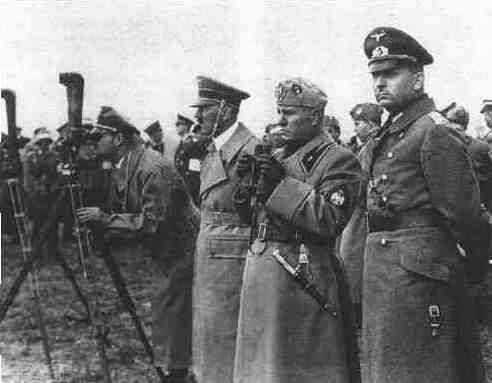
Official photographers captured two dictators, bending over a previously prepared huge map of hostilities, after which Hitler and Mussolini went to the intersection of roads in 18 km from Uman. At this point, a review was assigned to the Italian units that were heading to the front. This was the Torino division, which in German documents was listed as mechanized. Mussolini expected to show her to Hitler in all splendor, full of the proud Roman spirit. However, the soldiers passed 1300 km on foot from the Romanian border and were extremely tired. Motorcycles of the Bersalier battalions because of the rasputitsy most of the way overcame in carts and trucks. And now the Bersaliers, planted on them, with cocktails on their steel helmets, with their legs spread wide apart, drove along the slender, slippery road. The Germans looked darkly at this comical picture. Illusions about the fighting qualities of their allies they have left.
After Rundstedt reported on the course of the fighting of Army Group South, a plane with two dictators on board soared into the Ukrainian sky. And then the unexpected happened. Unexpectedly for all Mussolini, who to all other titles had also the title of "first pilot of the Italian empire," said that he personally wanted to lead the aircraft. There was a deathly silence. The SS guards, for whom such a step was equivalent to an attempted assassination of the Fuhrer, fixed their eyes on Himmler. For a good half hour the tension reigned in the plane. As Anfuzo recalled, “everyone thought about the possible headlines of the newspapers if the leaders of the Axis powers collapsed to the ground.”
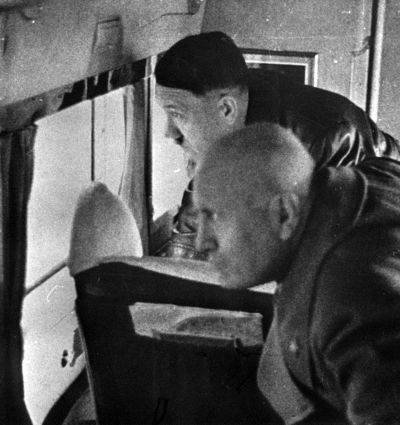
Already on the train, on the way to Italy, Mussolini reported that Ribbentrop intended to publish a communique on the visit, without agreeing with his Italian colleagues. Duce was furious. He demanded to tell the Germans that he would order the train to stop at the nearest stop and wait until he received the text of the communique. After the document was brought in, Mussolini highlighted the place where it was indicated that he personally piloted the aircraft with the Fuhrer on board.
Mussolini’s visit to Ukraine had no influence on the fate of the fighters of the expeditionary corps, who continued to knead the dirt on the sodden roads. In mid-September, the Italian units were concentrated at the Dnepropetrovsk bridgehead. At this point, the 7 forces of the German army encountered fierce resistance from our troops and were abandoned. Italian units participated in several local battles.
When they entered Dnepropetrovsk, the Italian soldiers were amazed that the population treated them even with more hostility than the Nazis. The reason for this was the insignia of the Italian army - white five-pointed stars, because of which they were mistaken for the White Guards. “Later, when the misunderstanding disappeared,” corps officer D. Fusco recalled, “the mysterious“ radio steppe ”carried information that these soldiers in green uniform were Italians. Unlike the Germans, people with a good-natured character, womanizer and, in general, little capable of cruelty. "
The war against the USSR was not needed by the Italian soldiers, and they did not want to shed their blood for the sake of implementing the plans of the fascist leadership that were far from them. Therefore, there could be no other outcome of the hostilities of the Italian corps on the Soviet-German front, except for a crushing defeat. But Mussolini’s attempt to bite off a piece of Ukraine for the Italians remained an unrealizable dream.
Sources:
Filatov G. Eastern campaign of Mussolini // Crusade to Russia. Collection. M .: Yauza, 2005. C. 8-26.
Safronov V. Italian troops on the Soviet-German front 1941-1943. M .: Science, 1990. C. 29.
Petrov B.N. Great Patriotic War // Military History Journal. 1993. # 8. C.10-14.
Runov V. 1941. Hitler's parade. The truth about the Uman slaughter. M .: Yauza, 2010. C. 144-145
Information